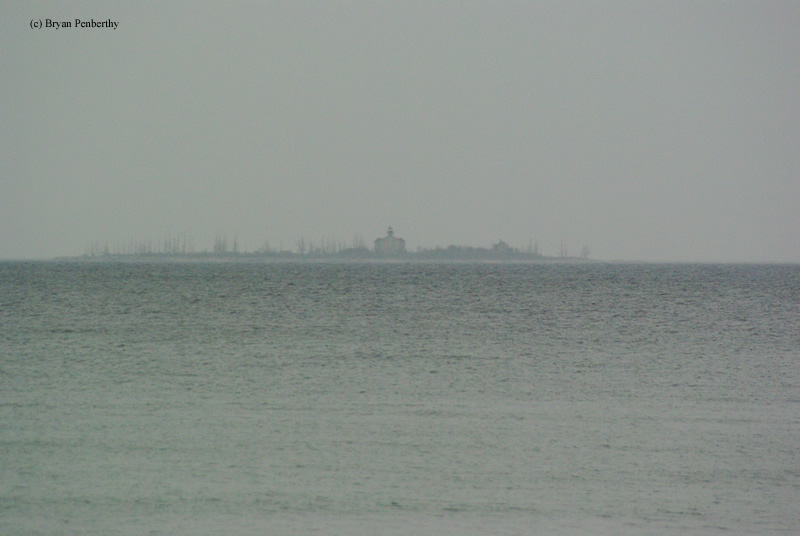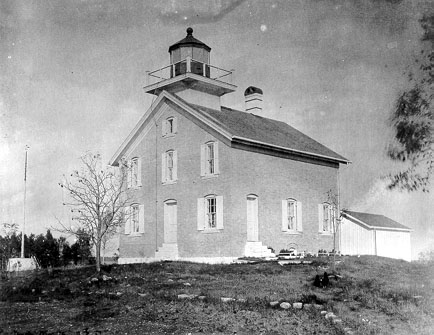Pilot Island Lighthouse
Pilot Island, Wisconsin - 1858 (1858**)

History of the Pilot Island Lighthouse
Posted/Updated by Bryan Penberthy on 2007-12-02.
The first lighthouse to mark "death's door", built in 1846, was on Plum Island. However, most mariners complained that the light on Plum Island was too far into the passage to be useful. The Lighthouse Board concurred and recommended Port Du Morts Island for a lighthouse in May of 1858. Port Du Morts Island, would later become known as Pilot Island. The original light on Plum Island, no longer needed after Pilot Island Lighthouse was in service, was abandoned.
 Pilot Island Lighthouse (Courtesy Coast Guard)
Pilot Island Lighthouse (Courtesy Coast Guard)
Later in 1858, crews landed with supplies and built a two-story dwelling made from Milwaukee cream brick. Through the western end of the roof, a tower was built and topped off with a 10-sided cast iron lantern room, and then filled with a fourth order Fresnel lens. At first, the lighthouse displayed a fixed white light, but changed to fixed red in 1891. Then, in 1894, it changed again, this time to a white light that flashed ever 15 seconds.
Given that the island was frequently shrouded in fog, a fog signal bell was added in 1862, but was upgraded to trumpet based fog signal that was driven by a caloric engine in 1864. Many mariners complained that the fog signal was inadequate, so the Lighthouse Board upgraded it in 1875 to a steam-powered signal. Since the steam-powered fog signal was at times unreliable, and since it would often take time to recycle the unit and get steam built back up, a duplicate fog signal and building was built in 1880. Only one unit was used at a time while the other served as backup.
A new fog signal building, added in 1900, housed an upgraded 10" steam whistle. Compressed air driven diaphones would replace the steam whistle in 1904. Other upgrades came to the station in 1904. To give the keeper and assistant some privacy, the lighthouse was split down the middle to create a duplex-like structure. This essentially divided the lighthouse into two separate living quarters. Wings, added on either side, helped create separate entrances and stairwells to the second floor.
At this time, a residence for the second assistant keeper came in the form of the unused fog signal building. It was converted to a living quarters. Additional buildings, constructed at this time, turned this station into one of the largest in the Door County Area. They included a boathouse, barn, several outhouses, oil house, workshop, and a dock. None of these structures exists today.
The lighthouse and fog signal building are all that remains of the once robust light station. The lighthouse, automated in 1962, now has a leaking roof, which is causing the floors and walls to rot. The last remaining fog signal building, also automated in 1962, and is barely standing. The roof has rotted through and collapsed. Despite all of this, the lighthouse is still an active aid to navigation. Today, a 300mm plastic optic replaces the original fourth order Fresnel lens.
The island is very different today compared to the time when light keepers occupied it. Today, due to almost no human contact, the island is haven area for nesting cormorants, a fish-eating bird, which have taken over the island. Numbering in the thousands, they are leaving a heavy footprint on the area. There is so much guano covering the island, that it has killed all of the remaining trees as evidenced in the picture above.
As of October of 2007, the U.S. Fish and Wildlife Service are now in possession of the island. Tim Sweet is leading a not-for-profit group, founded to try to save the lighthouse. Friends of Plum and Pilot Islands Inc. have been granted limited access to the island to try to shore up the lighthouse before winter, which includes installing a temporary roof to stop water from leaking in. The group will start raising funds for restoration; however, they do not know how much it will cost to restore the station.
Reference:
- Wisconsin Lighthouses: A Photographic & Historical Guide, Ken & Barb Wardius, 2003.
- Lighthouses of the Great Lakes: Your Ultimate Guide to the Region's Historic Lighthouses, Todd R. Berger and Daniel E. Dempster, 2002.
- Lighthouses of Lake Michigan: Past and Present, Wayne S. Sapulski, 2001.
- Great Lakes Lighthouses Encyclopedia, Larry & Patricia Wright, 2011.
Directions: The lighthouse sits off-shore on Pilot Island, owned by the U.S. Fish and Wildlife Service. Accessing the island is prohibited, and because of wind and weather, often times very dangerous. The best viewing spot from land is at the Washington Island Ferry dock at the tip of the Door County Peninsula. Ideally, the best way to view the lighthouse is via a boat trip offered from many providers in the area.
Directions: Grounds closed. Tower closed.
View more Pilot Island Lighthouse picturesTower Height: 41.00'
Focal Plane: 48'
Active Aid to Navigation: Yes
*Latitude: 45.28400 N
*Longitude: -86.91900 W
See this lighthouse on Google Maps.
